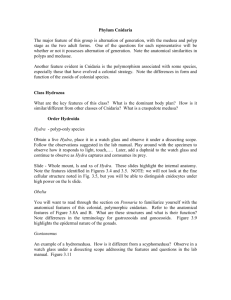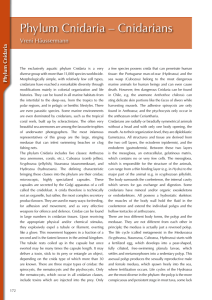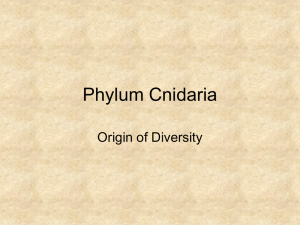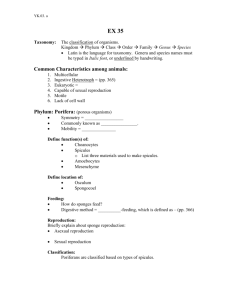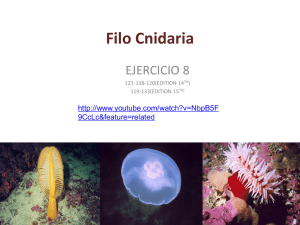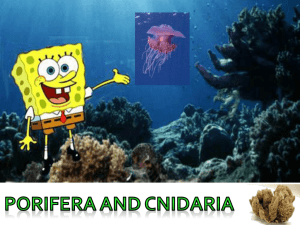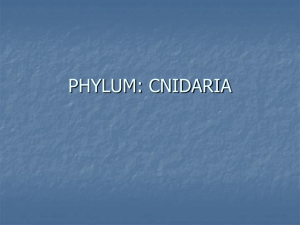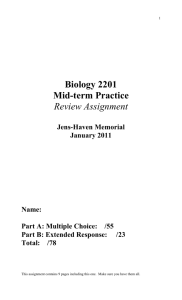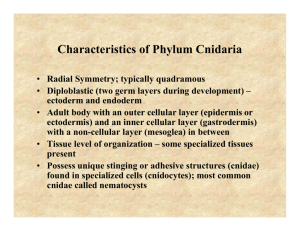Filo Cnidaria
advertisement
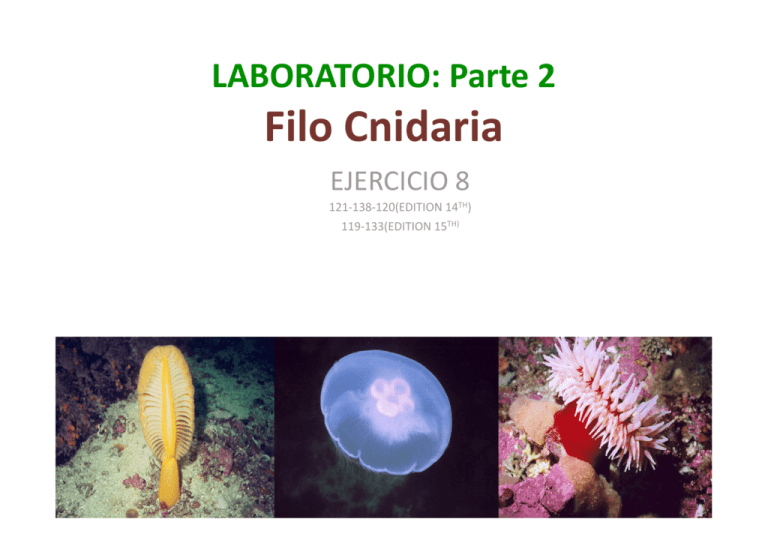
LABORATORIO: Parte 2 Filo Cnidaria EJERCICIO 8 121‐138‐120(EDITION 14TH) 119‐133(EDITION 15TH) Goals for today • Learn to recognized the Phylum Cnidaria from other animals • Learn the main ‘diagnosLc’ characterisLcs • Learn about some cnidarians biology • Learn about the internal anatomy of anemones Cnidaria Deuterostomia Ecdysozoa Cnidaria and Ctenophora Lophotrochozoa Porifera Radiate Animals Protostomia Radiata Parazoa Bilateria Eumetazoa • True mulLcellular animals • Radial or biradial symmetry • Simplest animals having a ?ssue level organiza?on. • However, Lssues of radiates are not organized into organs having specialized funcLons. Cnidaria Main characteris?cs of cnidarians are: • DiploblasLc: two germ layers (ectoderm and endoderm). • Internal space for digesLon= gastrovascular cavity. • Mesoglea: is a thin non cellular layer • Some have a skeleton (corals) but most radiates, have fluid in their gastrovascular cavity, and serves them as hydrosta?c skeleton. Cnidaria Main characteris?cs of cnidarians are: • Cnidarians have cnidocytes • Cnidocytes contain sLnging organelles called nematocysts • Each nematocysts contains a Lny capsule with a coiled thread like filament that injects a paralyzing toxin See video of nematocist sorry is in french! But excellent visualiza?on of this works Cnidaria Main characteris?cs of cnidarians are: • Polymorphism‐ some species of cnidarians have more than one morphological kind of individual • Polyp (hydroid) =sessile • Medusa (jellyfish)= free‐living Polyps= may reproduce by budding to form clones or colonies Medusas= reproduced sexually Classes: Cnidaria: Classifica?on Hydrozoa: • Both polyp and medusa stages present • Medusa with a velum • Fresh and marine water • Examples: Hydra, Obelia, Physalia Scyphozoa: • Medusa stage emphasized • Medusa without velum • Polyp reduced or absent • Enlarged mesoglea • Solitary • Examples: Aurelia Anthozoa: • All polyps • No medusa • Gastrovascular cavity is subdivided by mesenteries (septa). • Examples: Metridium, corals Other classes for which we don’t specimens but that you should know about: Cl. Staurozoa Cl. Cubozoa Cnidaria: Your Tasks Exercise 8A: – Phylum: Cnidaria – Class Hydrozoa • Genus: Hydra Hydras are freshwater solitary polyp forms, but are atypical hydrozoans because they don’t have medusa stage. Cnidaria: Hydra 1. Look at a slide of Hydra body parts: hypostome, mouth, tentacles. Can you see the basal disc? Cnidaria: Hydra 1. If you have a cross secLon of Hydra, try to idenLfy the following structure. Cnidaria: Hydra 2. Hydras reproduce asexually. Check if your slide of hydra has a bud Cnidaria: Hydra 2. Some hydra species reproduce sexually. Some species have separate sexes (dioecious) or an individual may have both (monoecious). Your instructor has hydras with ovaries. For comparison look at this photo of an hydra with testes Ovary testes Cnidaria: Hydra 3. Your instructor has staged a slide of an Hydra nematocysts Cnidaria: Something you should know Exercise 8A: – Phylum: Cnidaria – Class Hydrozoa • Genus: Physalia Physalia physalis “The man‐of war” is oden mistaken for a jellyfish. However, this animal is a floaLng hydrozoan colony, made up of four polyp types: pneumatophore (float), dactylozooids (tentacles for defense and prey capture), gastrozooids (feeding), and gonozooids (reproducLon) Look at the preserved Physalia Cnidaria: Your Tasks Exercise 8A: – Phylum: Cnidaria – Class Hydrozoa • Genus: Obelia Obelia is a marine colonial hydroid. Obelia has both polyp (hydroid) and a ?ny medusa (jellyfish). Cnidaria: Obelia 1. Look for your slide of Obelia. The colony: Coenosarc Living part of the colony stem Perisarc Non-living protective cover that protects the coenosarc Cnidaria: Obelia 1. Look for your slide of Obelia. ReproducLve polyps Gonopore Medusa buds Gonotheca Gonangium Reproductive poly with medusae that arise by budding Cnidaria: Obelia 1. Look for your slide of Obelia. Feeding polyps Hydrotheca Hydrant Feeding polyp that captures and ingests prey Cnidaria: Obelia 1. Look for your slide of Obelia. The cycle The life cycle of Obelia alternates between a sessile polyp stage and a swimming medusa stage. Cnidaria: Obelia 2. Look at the slide of the Lny Obelia medusa. Medusas are dioecious Cnidaria: Your Tasks Exercise 8B: – Phylum: Cnidaria – Class Scyphozoa • Species: Aurelia aurita Aurelia aurita “moon jelly” is a marine scyphomedusa. The mesoglea is thicker. Sexes are separate. The gastrovascular system has more canals. They have a tretamerous radial symmetry. Cnidaria: Aurelia 1. Take a look of scyphomedusa body parts A= mouth B= Gonad C= oral arm D= gastric pouch E= radial canals F= ropalium (sense organ containing statocyst and ocellus) Cnidaria: Aurelia 2. Aurelia aurita life cycle Medusa Larvae planula Strobila stages Ephyra Cnidaria: Your Tasks Exercise 8C: – Phylum: Cnidaria – Class Anthozoa • Species: Metridium senile Metridium senile is a common species in northern seas. They oden reproduce asexually by pedal laceraLon, and are said to be capable of binary fission as well. Sexual reproducLon also occurs. Diet is mostly small zooplankton, though they may also eat small benthic polychaetes, fish, and squid. anemone Cnidaria: Metridium 1. Take a look at the external anatomy A= mouth B= oral disc C= tentacles D= column E= acontia (armed with nematocysts) F= pedal disc Cnidaria: Metridium 1. Take a look at the internal anatomy Cnidaria: Your Tasks Exercise 8C: – Phylum: Cnidaria – Class Anthozoa • Corals Cnidaria: Corals 1. Observed the coral examples in the table. Make sure to note differences between them and the sponges! Corals are marine, typically living in compact colonies of many idenLcal individual "polyps". The group includes the important reef builders that inhabit tropical oceans, which secrete calcium carbonate to form a hard skeleton. wikipedia Cnidaria: Your Tasks 1. Observed the coral examples in the table. A coral "head", which appears to be a single organism, is a colony of myriad geneLcally idenLcal polyps. Each polyp is typically only a few millimeters in diameter. Individual heads grow by asexual reproducLon of individual polyps. Corals also breed sexually by spawning. Polyps of the same species release gametes simultaneously over a period of one to several nights around a full moon. wikipedia Cnidaria: Your Tasks Blanqueamiento de Corales Although corals can catch small fish and animals, such as plankton, using sLnging cells on their tentacles, most corals obtain the majority of their energy and nutrients from photosyntheLc unicellular algae called zooxanthellae. Zooxantela El blanqueamiento en los corales o "coral bleaching" se refiere a la pérdida o expulsión de zooxantela en las anémonas, corales y otros organismo fotosintéLcos, así como también a la reducción de pigmentos en la zooxantela cuando la misma expulsa las proteínas que caracterizan su color. What are the consequences of bleaching for the reef? Important Links Cnidaria http://www.ucmp.berkeley.edu/cnidaria/ cnidaria.html http://biodidac.bio.uottawa.ca/Thumbnails/ searchresults.htm? frompage=1&StartRow=513&sujet=&forma ttype=&auteur=Houseman&keyword=&phyl um=&datesoumis=&maxrows=64 http://www.biology.ualberta.ca/courses.hp/ zool250/Labs/Image-key.htm http://www.biol.wwu.edu/donovan/biol460/ Biology_460.html
